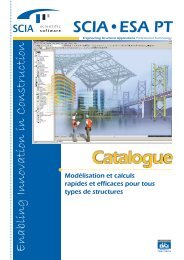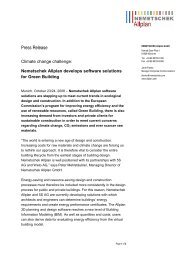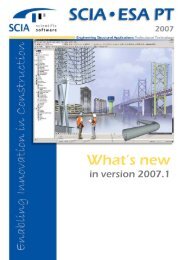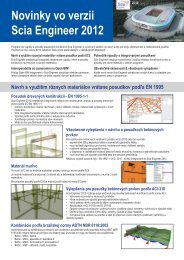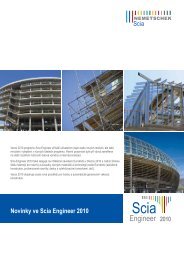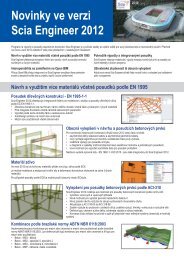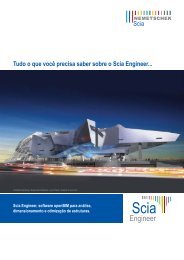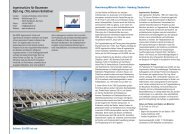VSH Turòa nad Bodvou - Nemetschek Scia
VSH Turòa nad Bodvou - Nemetschek Scia
VSH Turòa nad Bodvou - Nemetschek Scia
You also want an ePaper? Increase the reach of your titles
YUMPU automatically turns print PDFs into web optimized ePapers that Google loves.
Project: Bridge ‘Olsene’ across the ‘ Leie’ river<br />
Type: Arched bridge (Bowstring)<br />
Location: River “de Leie”, Dentergem (Oeselgem), Belgium<br />
Owner: Ministerie van de Vlaamse Gemeenschap - Afdeling Wegen<br />
en Verkeer West-Vlaanderen<br />
Architect: Ministerie van de Vlaamse Gemeenschap - Afdeling<br />
metaalstructuren, Brussels, Belgium<br />
Engineering office: Ingenieursbureau Stendess N.V., Lovendegem,<br />
Belgium<br />
Contractor: Steel: Victor Buyck Steel Construction N.V., Eeklo,<br />
Belgium - Concrete: Depret N.V., Zeebrugge, Belgium<br />
Total steel weight: ± 1.000 tons<br />
Total length: 112 m; Span: 110 m<br />
Highest point: ± 20 m (top of arches)<br />
Building period: 2005-2006<br />
Short description of the project<br />
The existing concrete bridge had to be replaced by a new bridge<br />
and this for two reasons.<br />
Firstly, the stability of the existing bridge was no longer guaranteed<br />
for the increased traffic intensity.<br />
Secondly, the free passing under the existing bridge was limited in<br />
height and width and too small for the current ships to pass.<br />
The new bridge is a steel bridge with a span of 110 m, consisting of<br />
2 drive lanes of 4 m and 2 lanes for pedestrians of 2,5 m. The bridge<br />
is an arched bridge (bowstring) with inclined arches of which the<br />
cross sections vary as well in height as in width along the bridge<br />
span. For the bridge deck an orthotropic steel deck with longitudinal<br />
trapezoidal stiffeners was chosen. The bridge is different from<br />
a classic bowstring bridge because the suspensions of the deck at<br />
the arch are not connected to the main deck beams. The suspensions<br />
are connected at the transverse beams, which support the<br />
main deck beams. The whole bridge was completely preassembled<br />
in the workshop, so that the assembly on the spot could be done<br />
smoothly.<br />
The erection, which was studied by Victor Buyck Steel Construction,<br />
was done using a ponton to support the bridge deck temporarily.<br />
In this work of art the great characters of steel came clearly to their<br />
right: the slim line and the playful form of the construction, speed<br />
of assembly and the possibility to combine heavy duty loads with<br />
an architectural design.<br />
Use of ESA-Prima Win and SCIA•ESA PT<br />
Description of technical questions to be solved with<br />
ESA-Prima Win and SCIA•ESA PT<br />
As well for the dimensioning of the steel bridge as for the dimensioning<br />
of the foundations (group of piles) ESA-Prima Win and<br />
SCIA•ESA PT were used.<br />
The complete 3D-model was formed with bars; the orthographic<br />
deck was put together as 2D-elements, with the purpose of creating<br />
the real vertical and lateral stiffness of the bridge. The tension bars,<br />
which support the deck, were simulated as classic bars.<br />
To simulate the horizontal (longitudinal) stiffness of the bridge<br />
supports, a 3D-model was made in which the 3D-bridge structure<br />
and the foundations (group of piles) were combined.<br />
For the calculations with regard to the traffic situation, each bridge<br />
member was given a buckling factor based on the rules of EC3. The<br />
beam check was then made by EC3 steel check of ESA-Prima Win.<br />
The buckling control of the arches was done in three ways. The<br />
first method with EC3-steel check of ESA-Prima Win, the second<br />
method was based on the calculation of the axial critical buckling<br />
force according EC3, the third method used the stability check and<br />
the second order calculation based on EC 3 of ESA-Prima Win. The<br />
second order calculation was done with SCIA•ESA PT. SCIA•ESA PT<br />
gives the possibility of a second order calculation with a predeformation<br />
based on a stability calculation for a 3D-model with bars<br />
and plates. Here SCIA•ESA PT really proved its progress compared<br />
to ESA-Prima win.<br />
In the calculation of this project the use of ESA-Prima Win was<br />
very intense and diverse:<br />
• Combination of 1D-elements and 2D-elements in one<br />
3D-model.<br />
• Combination of different materials in one model (steel bridge<br />
– concrete pile foundation)<br />
• Stability control / critical buckling factor<br />
• Second order calculation based on predeformations from<br />
stability calculations and on EC.<br />
• Use of graphical sections<br />
• Use of cross sections with variable height<br />
• Rib calculations<br />
• Free loads on 2D-model (orthotropic deck)<br />
Description of our experience with ESA-Prima Win and<br />
SCIA•ESA PT when realizing the project.<br />
The challenge in the calculations of the project was found in the<br />
different aspects of steel calculation and in the design of an architectural<br />
bridge for heavy loads.<br />
For this ESA-Prima Win and SCIA•ESA PT were the most suited<br />
software because of the variety of possibilities to check the structure<br />
to the limit, based on linear calculations, EC 3 steel check<br />
control, stability control and second order calculation in one software<br />
program. This could be done in a user friendly and structured<br />
software environment.<br />
Used modules:<br />
• Base<br />
• 3D frame<br />
• 3D shell<br />
• Stability frame<br />
• Second order calculation<br />
Bridge ‘Olsene’ across the ‘Leie’ river<br />
• Steel code check (EC3)<br />
• Rib calculation<br />
• Graphical sections<br />
• Cross sections with variable height<br />
73




